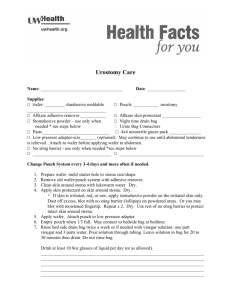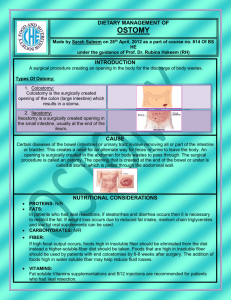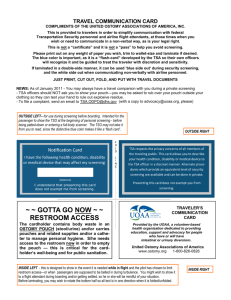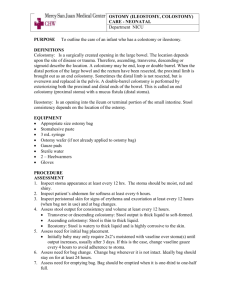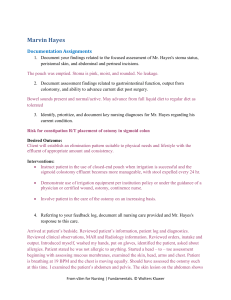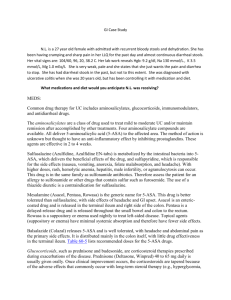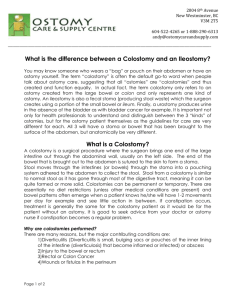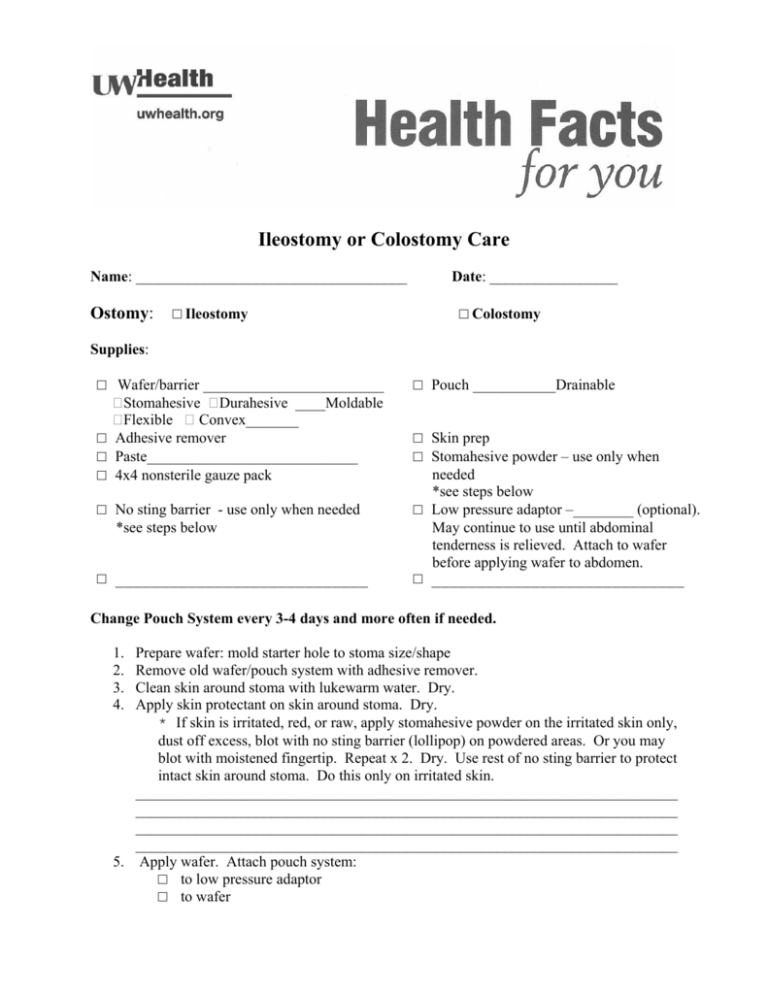
Ileostomy or Colostomy Care
Name: ____________________________________
Ostomy:
□ Ileostomy
Date: _________________
□ Colostomy
Supplies:
□ Wafer/barrier ________________________
Stomahesive Durahesive ____Moldable
Flexible Convex_______
□ Adhesive remover
□ Paste____________________________
□ 4x4 nonsterile gauze pack
□ No sting barrier - use only when needed
*see steps below
□ ____________________________
□ Pouch ___________Drainable
□ Skin prep
□ Stomahesive powder – use only when
needed
*see steps below
□ Low pressure adaptor –________ (optional).
May continue to use until abdominal
tenderness is relieved. Attach to wafer
before applying wafer to abdomen.
□ ____________________________
Change Pouch System every 3-4 days and more often if needed.
1.
2.
3.
4.
Prepare wafer: mold starter hole to stoma size/shape
Remove old wafer/pouch system with adhesive remover.
Clean skin around stoma with lukewarm water. Dry.
Apply skin protectant on skin around stoma. Dry.
* If skin is irritated, red, or raw, apply stomahesive powder on the irritated skin only,
dust off excess, blot with no sting barrier (lollipop) on powdered areas. Or you may
blot with moistened fingertip. Repeat x 2. Dry. Use rest of no sting barrier to protect
intact skin around stoma. Do this only on irritated skin.
________________________________________________________________________
________________________________________________________________________
________________________________________________________________________
________________________________________________________________________
5. Apply wafer. Attach pouch system:
□ to low pressure adaptor
□ to wafer
If using a 2 piece system, check coupling system to ensure system is completely closed.
To secure invisiclose tail end closure for drainable pouch (Velcro), press interlocking closures
together until you feel them lock or click into place along their entire length. Do the same with
the security flap.
Empty pouch when it is 1/3 full. Clean inside of tail end closure after being emptied.
Drink at least 10 8oz glasses of liquid per day (or as allowed).
•
•
Ileostomy: Maintain “applesauce” stool consistency with liquids and diet.
Colostomy: Maintain “loose oatmeal” stool consistency with liquids, diet and
recommended bowel regimen.
Go to the nearest emergency room if stoma turns dark color (dusky blue, grey, brown or
black) or if stoma is bleeding.
For other concerns, questions or problems, call:
Digestive Health Center: 608-890-5000 General Surgery Patients.
Gynecology Oncology Clinic: 608-263-1548 Gynecology Oncology Patients.
Transplant Clinic: (608) 263-1385
Notes:
Discharge Ostomy Supplies
Ostomy supplies are usually covered by your insurance. If you have Medicare, it will pay 80%
of the cost. If you also have a supplemental insurance plan, it will cover the other 20%. It is best
to find out first from your supplemental insurance where you can get your ostomy prescription
filled. Many private insurance plans or HMOs will pay the full cost of the supplies as long as
they have been prescribed by a doctor. Your prescription will need to be renewed every 90 days
to keep having the cost of supplies covered. After 6 months, it can be renewed by your primary
care doctor.
We will provide you with a small number of supplies when you go home. If you have been set
up for home health visits at discharge and you have Medicare, they will provide you with
supplies while you’re followed by Home Health. Once you have been discharged from Home
Health, call the Digestive Health Center (for General Surgery Patients) at 608-890-5000 or the
Gynecology Oncology Clinic (for Gynecology / Oncology Patients) at 608-263-1548 and leave a
message for your Doctor’s nurse with the name of your preferred provider for ostomy supplies.
We will fax or e-mail your prescription to them. They may mail the supplies to you or you may
need to pick them up. Your provider may set a regular schedule to deliver your supplies. Others
may want you to call when you need more. They will need a copy of your prescription.
If you do not have Home Health or Medicare, you will be discharged to home with enough
supplies until your first clinic visit. At that time, you will receive a prescription for more ostomy
supplies. We can fax or e-mail this to your provider, or you may take it with you.
Do not order too many supplies before your first clinic visit. Most stomas shrink. You will
likely need a new prescription with your new flange size at that clinic visit.
Colostomy and Ileostomy Diet Guidelines
Adequate nutrition is important to your well-being. The foods you choose to eat provide both
nourishment and pleasure. All of the foods you enjoyed before surgery, with a few exceptions,
should be well tolerated now that you have an ostomy. Many people with ostomies can enjoy a
normal diet; however, food tolerances can vary from person to person.
General guidelines that will help make caring for, and eating with, your ostomy easier include:
Eat meals regularly. You should eat three or more times a day. Small frequent meals
may be better tolerated and produce less gas.
Chew your food thoroughly. Chewing well will help avoid a blockage.
Eat in moderation and slowly. Too much of any food can cause problems, so eat
moderate amounts and eat slowly to allow for proper chewing and digestion. If a new
food seems to give you problems, don’t eat it for a few weeks, but try it again later.
Drink plenty of fluids daily. You may lose more body fluids than usual through the
ostomy, so it’s important to stay hydrated. Patients who have lost a large part of their
large intestine will especially notice more fluid loss. This is because most of the body’s
fluid is normally reabsorbed in the large intestine.
Above all, remember that no two people will respond the same to each food. You
will learn through experience which foods, if any, you should avoid.
Reducing gas and odor
Gas is normal but if you feel you are having excess gas, you may try to change your diet to
eliminate the problem. Try these tips:
Eat regularly. Do not skip meals.
Avoid swallowing air while eating. Relax and eat slowly.
Avoid chewing gum or drinking through a straw.
Drink 8-10 glasses of water, cranberry juice, or other non-caffeinated beverages.
Foods that may cause gas or odor
Asparagus
Apples
Bananas
Beer
Broccoli
Brussels sprouts
Cabbage
Carbonated beverages
Cauliflower
Corn
Cucumber
Dairy products
Dried beans/peas
Eggs
Fatty foods
Grapes
Green pepper
Melons
Onions
Prunes
Radishes
Turnips
Beans
Mushrooms
Foods that may help prevent gas and odor
Yogurt with Active cultures
Buttermilk
Cranberry Juice
Parsley
Preventing Blockage
Certain foods, if eaten in large amounts and not chewed well, may cause blockage. Use caution
when eating these foods. Eat them in small amounts and be sure to chew them thoroughly.
Celery
Coleslaw
Corn, whole kernel
Dried fruits
Meat casings
Mushrooms
Nuts
Peas
Pineapple
Popcorn
Salad greens
Seeds
The consistency of your stools is determined to a certain extent by the location of your stoma in
your gastrointestinal (GI) tract. Normally, when the stoma is placed further up in the GI tract,
the stools tend to be looser. In some cases, a loose stool may be the result of eating certain
foods.
Foods that may cause loose stools
Alcoholic drinks
Apple juice
Baked beans
Tomatoes
Chocolate
Coffee
Dairy
Fried Foods
Grape Juice
Green leafy vegetables
Licorice
Prune juice
Spiced foods
Peanut butter (creamy)
Rice
Soda crackers
Tapioca
Weak tea
Foods that may help thicken stools
Applesauce
Bananas
Cheese
Cream of rice
Marshmallows
Mashed potatoes
A Special Note for Ileostomy Patients
A person with an ileostomy loses large amounts of salt, potassium and water in the ostomy fluid.
Losing too much can lead to dehydration. You need to include several good sources of sodium
and potassium in your daily diet. It is helpful to consume water or sugar free, non-carbonated
beverages throughout the day. Sports drinks can be used because of their electrolyte content.
The color of your urine should be clear to pale yellow, if it is darker increase your fluid intake.
In general, meats, legumes, vegetables, and fruits are good sources of potassium. Some
examples include bananas, orange juice, tomatoes, and potatoes.
Most importantly, remember to eat a healthy, well balanced diet and drink plenty of
fluids!!
Internet resource for patients who have an internal ileal pouch: www.J-pouch.org
If you have more questions please contact UW Health at one of the phone numbers listed below.
Nutrition Clinic
Digestive Health Center
750 University Row
Madison, WI 53706
(608) 890-5000
Nutrition Clinic
UW Health East Clinic
5249 East Terrace Drive
Madison, WI 53718
(608) 265-0963
Copyright © 3/2013. University of Wisconsin Hospital and Clinics Authority. All rights reserved. Produced by the
Department of Nursing. HF#6279

